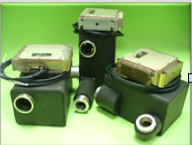
PROJETS:




Press arrow for more illustrations



Press arrow for more illustrations




Press arrow for more illustrations
HEATERS
Projects related to the heating of the air have been developed for the aviation industry. The intention - to control the temperature of the flow of air, in particular in-flight temperature is maintained at 100 (+ 5) ℃.
The heating system includes a number of heating elements depending on the required heating temperature. Control algorithm implements a microcontroller program. Projects take into account all the necessary standards for the aviation industry:
-
standards related to the design and manufacture of printed circuit boards,
-
standards related to voltage supplies,
-
standards related to electromagnetic compatibility,
-
standards related to vibration.
PTC heating elements
PTC thermistors are temperature sensitive semiconductors flint. These devices have a very high positive temperature coefficient, and hence can be used for various applications involving heating. Temperature of a specific PTC heating element (in a workspace) is independent of the current flowing through the element.
Temperature meter RTD.
Platinum resistance temperature detector (RTD) is a device with the characteristic impedance of 100 Ω at 0 ° C. It consists of a thin film of platinum on the plastic film.
Its resistance depends on the temperature, and it can usually measure the
temperature from 0 to 850 ° C.
Passing DC current through the RTD generates a voltage across the RTD. By measuring this voltage, it is possible to determine the RTD’s resistance and thus its temperature. The relationship between resistance and temperature is relatively linear.
GUI
GUI designed for checking and adjusting electronic heaters. This allows to receive an manage all the device parameters (current, voltage, temperature). GUI is being developed based on the program ‘Labview’.
.
PID controller for brushless (BLDC) motors.
This project involves the control of BLDC (Brushless DC) motor drive for adjusting the angle of lift of an airplane wing. BLDC more reliable than the DC motor as the mechanical switches are replaced with electronic switches. In BLDC motor rotor magnets generate magnetic flux, that way the system achieves a higher efficiency. Regulation is carried out in accordance with the demand of the angle in the form of an analog signal. To measure the actual angle (or phase) position sensors Hall is being used. The system has a feedback type angle - the demand. The system is based on the principle of PID.
PID controller calculates an error value, as the difference between the measured process variable (angle) and the demanded value of this angle. PID allows to minimize this error value. (See diagrmme)
.This diagram illustrates the principle of operation of the PID controller. Coefficients in front of the integral and derivative omitted for the clarity of illustration.
The controller works with an accuracy of + 0.6 ℃
Liquid level sensor.
Capacitive liquid level sensors is widely used to measure the amount of fuel in the aircraft. The sensor consists of a pair of metal cylinders that are inserted into each other (sometimes complex shapes to ensure linearity of the sensor in a complex
form of the tank), immersed in the fuel. The principle
of operation is based on a sensor that is directly proportional to capacitance of the dielectric constant of the insulator, and ε have different air and fuel
(approximately 1 and 1.8, respectively). As a result, when filling the fuel tank increases the reactance of the sensor.
The devise’s feeds from common network aircraft (LA 115 V 400 Hz.). The total error is less than 0.4% of the sensor.
This high accuracy is achieved through the use of CTMU of the controllers PIC. CTMU allows high accurately measure the time charge capacity.






